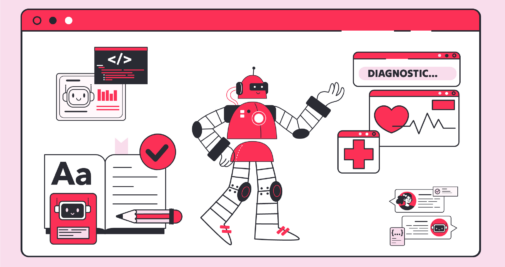This website uses cookies so that we can provide you with the best user experience possible. Cookie information is stored in your browser and performs functions such as recognising you when you return to our website and helping our team to understand which sections of the website you find most interesting and useful.
Digital transformation is undoubtedly one of the most sought-after changes in the business world today. As a matter of fact, it’s not just in business but across many spheres and domains that want to stay relevant. From healthcare, education, and non-profit all the way to banking, manufacturing, and even agriculture – many areas are investing heavily in digital transformation.
However, despite their best intentions, the digital adoption failure rate – according to a longitude of studies – floats around a staggering 70% to 95%. That means that on average a mere 2 in 10 organizations live to see the full range of benefits from digitization.
Keep on reading if you want us to explore together the reasons behind these gloomy numbers. Moreover, we’ll try and present you with a few ways that may help you to stay on the positive side of the charts. Most importantly – and this is a big hint – we’ll try to prompt you to help people on all company levels understand that this change – the digital transformation – is about them.
First, though, let’s address the elephant in the room…
4 Ways to Make Your Corporate Culture an Ally in Digital Transformation

#1 Meet employees’ needs first
“You can’t build a great building on a weak foundation.”
– Gordon B. Hinckley
Digital transformation, advanced AI, robotization, and all kinds of technological fuss… The buzzwords get thrown around more often these days and people can’t help but notice – not any of this jargon is about them. Have their needs and wants been met first? How does your workforce fit within this grand scheme of the future? Is there a chance this sea of changes is worrying them and causing stress?
Fostering a tech-first narrative may be hurting people’s feelings and how they approach the work. There are solid reasons to believe that in many cases it’s pulling people away from their employers and that it may be feeding a record-high work disengagement.
To turn the page around, people-first companies are focused on meeting their employee’s needs first and building from there. From a more solid, disruption-withstanding basis. Laying bricks over a toxic work culture and employee neglect has not once crumbled companies’ aspirations. To set a solid foundation where people are making, not breaking, the digital transformation you may want to check with an HR department whether their core needs are truly met first.
- Physical health. Ergonomic workspaces, internal health advice, regular medical examinations, holiday and vacation leaves, mental health programs, gym membership, etc.
- Emotional well-being. Are employees feeling valued in their contribution through all hierarchical levels? Do they have the opportunity to share their achievements and hurdles without judgment or career scares?
- Focused work. Are projects and tasks delegated in an organized way? Can your employees stay productive and focus on the most important work without interruptions throughout parts of the day? Do your employees lack the structure that helps them stay productive?
- Meaningful work. Are your employees engaged in the work they do best? Do they truly think they are contributing to a higher purpose? Do they think they are building a meaningful career with your company?
#2 Before you digitize, de-digitize
Have you ever read about lithium-ion batteries? Long story short, these rechargeable cells don’t like being connected to a power source all the time. They prefer their power cycle wavering up and down without ever hanging too long around the top or the bottom power level. It’s how they thrive and keep your devices in shape for the long haul.
People in their relationship with digital – and bear with us for a moment – are in many ways like this. We spend too much time devouring information, use 3-4 personal devices to get around and stay plugged in way more than we should. Just like batteries – sounds off we know – if we’re constantly charged at 100% it’s detrimental to us. Now you may wonder, and rightfully so, how is this related to digital transformation?
Well, all four aspects of employees’ needs we mentioned in the first point – physical, emotional, mental, and spiritual – are in jeopardy due to digital overload phenomena.
Research has shown that spending excessive screen time leads to higher stress levels. This stress can manifest in a variety of ways, ranging from irritability and trouble relaxing and sleeping to physical symptoms like headaches and fatigue. On a broader, company-wide level it may provoke a negative domino effect. Burnt-out employees don’t perform at their best, creativity and collaboration dwindle down, and overall feeling of content, meaning, and engagement evaporate. Can you see how this weakens the foundation necessary for a successful digital transformation?
Fret not. There are ways companies are fruitfully building back a strong and satisfied company culture. To de-digitize, you may want to consider one of the following approaches:
- Incentivize limits on uninterrupted screen-time
- Encouraging employees to take breaks without phones
- Creating tech-free zones
- Encouraging team building in nature
- Designing ergonomic work environments
#3 Explain digital transformation to your executives

From our experience in supporting companies to meet higher digital standards, we couldn’t resist but notice a usual set of patterns in approaching this change. Leaders and change-makers tend to underestimate the seriousness of digital transformation. Seeing the great-looking big picture of (e.g.) business intelligence and ignoring the nitty-gritty, leadership tends to neglect truly committing to a change.
Consultants and partners are great and they do propagate a digital shift, but they are not the ones who know your company from top to bottom. Your leaders, C-level executives, and senior managers should be the prime movers of this digitated shift. It helps executives if they understand that digital transformation is not just one in 15 business objectives. It’s a core change in a company’s identity. No plan on how to involve the right people in the right stages, no responsibility governance, and therein lack of support by the unassuming company culture. It all adds up to nudge the majority of starry-eyed company leaders blindfolded over a steep cliff.
Starting from there, having executives’ devotion to this long-term project is crucial. Not only does it feed more realistic expectations but it also helps to create a matter-of-fact roadmap that leads to milestones. Most importantly, collaborative culture is shaped by leadership. Meaning, you won’t get your people’s blessing if leadership is not united and on board with a digital transformation.
#4 Build employee personas
What often follows as an outcome of a sudden shift is a cultural resentment of digital transformation. Your people, your culture carriers, won’t be on your side if you don’t help them understand the importance of this shift and how it’s serving them. You need to lay out the steps to involve them and make sure you’re aware of potential cultural bottlenecks of this change.
As shared in the HBR pulse survey, Susanne Arnoldy, a head of digital for the advisory PwC business in Germany says that building employee personas may do the trick. “Someone who is 20 years in the firm and has no experience with technology needs another kind of communication, compared to someone who’s just coming from university or has studied informatics,” suggests Arnoldy. To remedy these diverse perceptions of digital change Arnoldy says it helps to start by forming change management teams. These special assemblies could create average employee profiles based on their preferences, interests, technical knowledge, and ways of dealing with change.
On top of that, Arnoldy says that PwC puts digitally-apt people at the forefront of these teams. The individuals the rest of the company is likely to look up to in terms of digital understanding. The very reason is that these digital natives can without over-exertion run workshops and training over a long period of time and support others’ growth.
Not everyone is going to keep the same pace. Having people who are held accountable to support others at least helps everyone understand that it’s OK to maintain their own rate of progress.



